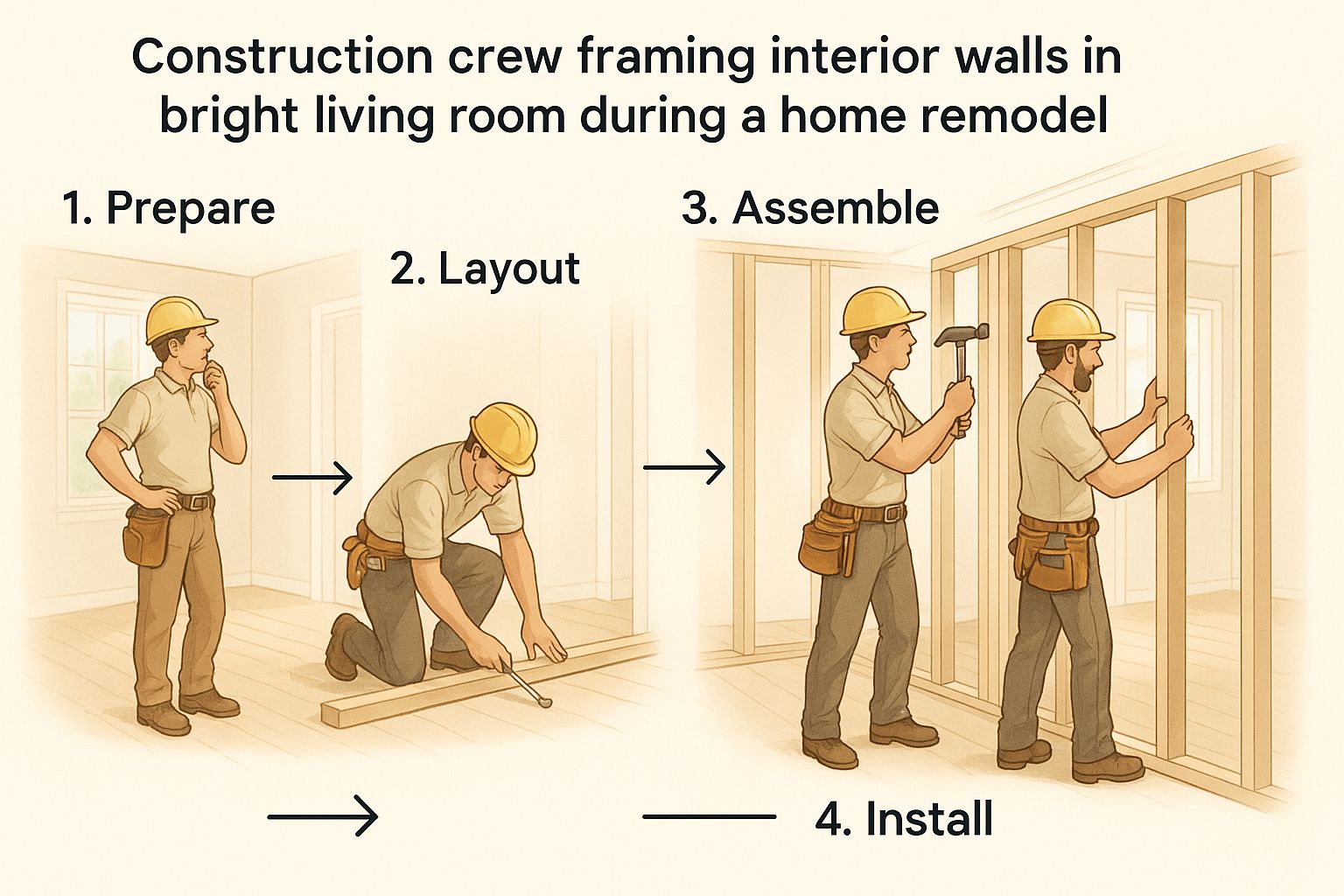Jumping the gun and searching for "home remodel contractors near me" before you've done your homework is one of the biggest mistakes homeowners make. The first, most critical step is to define your vision. A clear, detailed plan is your best friend—it turns fuzzy dreams into a concrete scope of work that contractors can actually use to give you an accurate bid.
Skip this part, and you're setting yourself up for miscommunication, surprise costs, and the very real risk of hiring the wrong team for the job.
Get Clear on Your Remodel Before You Start the Search

Starting the hunt for a contractor without a solid plan is like going grocery shopping when you’re hungry and have no list. You’ll end up with a cart full of stuff you don’t need and a bill that’s way over budget. A well-defined project scope is the absolute foundation of a smooth renovation.
And this isn't just about a Pinterest board. This is about making real decisions that shape your budget, your timeline, and the kind of professionals you'll attract. The home remodeling market is absolutely massive—recently valued at around USD 950 billion globally and still growing. That means good contractors are in high demand. They want to work with clients who have a clear, actionable plan, not a vague wish list.
Nail Down Your Project Scope
You need to get specific. Really specific. "Remodel the kitchen" isn't a plan; it's an idea. For a deep dive into this, our guide on how to plan a kitchen remodel is a great place to start.
Think through these key areas:
- Layout Changes: Are you knocking down walls? Moving the sink to the other side of the room? Any time you touch plumbing, electrical, or structural elements, the complexity and cost jump significantly.
- Material Selections: This is where you really define the project's feel and budget. Be explicit: are we talking laminate countertops or quartz? Luxury vinyl tile or solid hardwood floors? The difference is thousands of dollars.
- Must-Haves vs. Nice-to-Haves: Make two lists. Seriously. Your "must-haves" are the non-negotiable items. The "nice-to-haves" are the dream features you'd love if the budget allows. This gives you instant clarity on where your money should go first.
A detailed scope of work is the only way you can get true apple-to-apples bids from different contractors. It becomes the rulebook for the project, holding everyone accountable to the vision you created.
Set a Realistic Budget and Timeline
Here's a pro tip: your budget isn't just the cost of materials and labor. You absolutely must include a contingency fund of 15-20% for the unknowns. Every old house has secrets, whether it's mold behind a wall or funky wiring from the 70s. This buffer saves you from a world of stress.
The same goes for your timeline. Factor in potential delays for things like custom cabinet delivery or city permit approvals. When a contractor sees you’ve already thought through these practical details, it signals that you're a serious client who is ready to get to work.
Finding The Best Local Remodeling Professionals

Alright, you’ve got your plan mapped out. Now for the big part: finding the right people to bring it to life. Firing up a search engine might seem like the obvious first move, but you’ll be hit with a tidal wave of options.
The home remodeling industry is booming. There are roughly 726,026 remodeling businesses in the U.S., with over 111,800 of them popping up in just the last five years. That's a lot of noise to sift through. For a deeper dive into these numbers, Fixr.com offers some great insights into home remodeling trends.
So, where do you start? The single most reliable method, time and again, is a good old-fashioned referral. Ask friends, family, and neighbors who they’ve hired. But dig deeper than just "Were you happy?" Ask about the real-world stuff: How was their communication? Did they stick to the schedule? What happened when something unexpected went wrong?
Go Beyond Your Immediate Circle
Your personal network is a fantastic starting point, but don't stop there. Think about other professionals you already trust—your real estate agent, maybe an architect or an interior designer. These folks work with contractors constantly and usually keep a shortlist of reliable crews they're happy to recommend.
Here’s a pro tip: visit your local building supply store. I’m not talking about the big-box giants, but the independent lumber yards and specialty suppliers where the pros shop.
The people behind the contractor desk see these builders every single day. They know who's busy (a good sign), who pays their bills on time, and who’s buying quality materials versus cutting corners. A quick, friendly chat can give you some of the best insider leads you'll find anywhere.
Using Online Platforms Smartly
Once you've gathered a few names from trusted sources, it's time to head online. The key is to use websites for verification, not for your initial search.
- Dive into Local Reviews: Platforms like Houzz or even local Facebook groups can be goldmines. Skip the one-line "They were great!" reviews and look for the detailed stories that walk you through the entire project.
- Check Their Track Record: The Better Business Bureau (BBB) is still a solid place to check a company’s history. It’s where you’ll find formal complaints and see how (or if) the contractor resolved them.
By blending personal referrals with professional recommendations and then backing it all up with some smart online vetting, you’ll build a solid shortlist of high-quality, trustworthy contractors.
How To Properly Vet Your Contractor Shortlist
You've put in the time and narrowed down your list of potential contractors. Fantastic. But now comes the most critical phase—the part that truly separates a smooth, successful project from a complete nightmare. Vetting isn't just about looking at pretty pictures in a portfolio; it's a deep dive to confirm you're hiring a team that's professional, reliable, and can actually bring your vision to life.
Think of yourself as the hiring manager for a major investment in your home. You wouldn't hire a key employee without a thorough interview and background check, right? Don't gamble with your home by rushing this process.
This infographic breaks down the essential vetting steps, from initial background checks to getting that final confirmation.

Seeing the process laid out visually really shows how each piece of the puzzle—from licenses to client feedback—builds a complete picture of a contractor's trustworthiness.
Verifying The Essentials: Licenses And Insurance
First things first, let's cover the non-negotiables. Every single contractor on your list must be properly licensed and fully insured. This is your most basic protection against things going wrong.
Ask each one for a copy of their state license, their certificate of liability insurance, and proof of workers' compensation. Don't just take their word for it. Head over to your state's licensing board website and verify their license is active and in good standing. It’s a quick check that can save you a world of headaches.
Pro Tip: If a contractor ever asks you to pull the building permits for the job, that’s a giant red flag. The person whose name is on the permit is legally responsible for the work. A professional contractor will always, always handle this themselves.
To keep your verification process organized, use a simple checklist. It helps you systematically compare each contractor without letting important details slip through the cracks.
Contractor Vetting Checklist
Use this checklist to systematically verify credentials and references for each potential contractor.
| State License | Request license number; verify status on the state board's website. | |
| General Liability Insurance | Ask for a current Certificate of Insurance (COI). | |
| Workers' Compensation | Request proof of coverage for their employees. | |
| Client References | Get a list of at least 3 recent clients. | |
| Supplier References | Ask for names of 1-2 main material suppliers. | |
| Portfolio Review | Look for projects similar in scope and style to yours. |
This simple tool ensures you're making an apples-to-apples comparison based on facts, not just a gut feeling.
Talking To Past Clients
A contractor's portfolio shows you the final product, but their references tell you about the journey. Any reputable contractor will be happy to provide a list of recent clients. When you make those calls, don't just ask, "Were you happy with the work?" That's a yes-or-no question that won't tell you much.
You need to dig deeper to understand what it's really like to work with them.
Try asking more specific, open-ended questions:
- On the Money: "How did the final cost compare to the original estimate? Were there any financial surprises along the way?"
- Staying in the Loop: "How did the project manager communicate with you? Did you feel informed and were they responsive to your calls or emails?"
- When Things Went Sideways: "Did any unexpected problems pop up? If so, how did the contractor handle the situation?"
- The Crew: "How did you feel about the crew being in your home every day?" The right construction team is not only skilled but also respectful of your space.
These questions uncover the truth about a contractor's process, communication style, and ability to perform under pressure—details you’ll never find in a glossy brochure.
Decoding Bids To Make The Right Choice
When the bids start rolling in from your top home remodel contractors, it’s incredibly tempting to jump straight to the bottom line. But take a breath and resist that urge. The cheapest bid is almost never the best one, and an unusually low number often signals hidden costs, cut corners, or future headaches.
A genuinely professional bid is an open book. It should be a detailed, itemized breakdown that shows you exactly where your money is going. This isn't just about transparency; it's about showing you they've thought through every single step of your project. The U.S. home remodeling market is massive—valued at over USD 498 billion recently—so there are plenty of pros competing for your business. It's worth taking the time to find one who's upfront from the start. For more on this, you can explore these remodeling industry projections.
Look Past The Grand Total
A single, lump-sum number on a proposal is a huge red flag. A quality bid should be meticulously broken down into clear categories. This is the only way you can truly compare bids “apples-to-apples.”
A proper bid should clearly show:
- Labor Costs: This should be detailed, covering everything from demolition and framing to the specific plumbing, electrical, and finish work.
- Material Costs: You should see specifics, not just vague terms like "bathroom fixtures." A good bid will list brands, models, or at least a clear quality standard.
- Permit Fees: The contractor should outline the estimated costs for all the required municipal permits.
- Allowances: These are essentially budget placeholders for items you haven’t picked out yet, like tile, countertops, or light fixtures.
Pay very close attention to those allowances. Some contractors intentionally lowball them to make their bid seem more attractive. For instance, a $500 allowance for a bathroom vanity might sound okay, but that'll barely get you a basic model from a big-box store. If your vision includes something more custom or high-end, that tiny allowance will immediately trigger a change order and blow up your budget. Getting familiar with what things actually cost is key; you can see a realistic example in this complete bathroom renovation cost breakdown.
Remember, the best bid isn't the lowest one. It's the one that proves the contractor fully understands your project and has priced it out with detailed, realistic numbers.
Spotting Vague And Deceptive Language
Go through every line item with a fine-tooth comb. Vague phrases like "install new flooring" or "electrical as needed" are traps. They leave far too much open to interpretation—and potential disagreement later.
A pro's bid will be specific. It won't just say "install flooring"; it will say "install 250 sq. ft. of specified LVP flooring." It won't say "electrical as needed"; it will say "install four new recessed lights and two GFI outlets in the kitchen."
By insisting on this level of detail from every home remodel contractor you're considering, you force them all to bid on the exact same scope of work. This clarity is your best defense against misunderstandings and protects your investment right from the get-go.
It's All About the Contract: Your Project's Ultimate Safeguard
A handshake and a friendly smile are great, but they won't protect your investment. The contract is the one thing that truly matters when the work begins. Don't ever rush this part or treat it like a simple formality. It’s the single most critical document for keeping your project on time, on budget, and aligned with what you actually want.
Think of it as the official game plan for your entire renovation. It takes all those conversations, bids, and promises and turns them into a legally binding agreement. A poorly written or vague contract is just asking for trouble, leading to misunderstandings and expensive arguments later.
What to Look For in a Rock-Solid Remodeling Contract
Before your pen ever touches that paper, comb through the document to make sure these essentials are covered. Each one is a layer of protection that clearly defines who is responsible for what, setting firm boundaries for you and your contractor.
- A Detailed Scope of Work: This is the core of the whole agreement. It needs to spell out everything—from demolition and debris removal to the brand of paint and the model number of the faucets. If it's not in writing here, it's not officially part of the job.
- The Total Project Cost: The contract must state the total fixed price for the project. Never, ever sign a deal based on a loose "estimate" or a "cost-plus" arrangement without a guaranteed maximum price.
- A Firm Timeline: There should be a specific start date and a projected completion date. This isn't just a suggestion; it’s a commitment that creates accountability and helps you plan your life around the work.
- A Clear Payment Schedule: This is a big one. Payments should always be tied to specific, completed milestones—not just random dates on a calendar. For example, a payment is due after the framing is finished and has passed inspection, not just "on the 15th."
Be very wary of any contractor demanding a large sum of money upfront. In many states, the legal limit for a down payment is 10% of the total project cost or $1,000, whichever is less. This law exists to protect homeowners from paying for work that hasn't even started.
Finally, make sure the contract clearly explains the procedure for handling change orders. Life happens, and you might want to add a feature or change a material mid-project. A formal, written process ensures any additions or subtractions from the original plan—and the cost differences—are approved by you in writing before the work is done. No surprise bills allowed.
A Few Common Questions About Hiring a Remodeler
It's completely normal to have a ton of questions when you're about to tear up your house. Getting a few key things straight from the get-go can save you a world of headaches down the road, especially when it comes to the money side of things.
How Should I Pay My Contractor?
This is a big one. You should never pay a huge amount of cash upfront. A reputable pro won’t ask you to. The standard practice is a modest down payment—often around 10% of the total project cost. In some places, like California, the legal cap is even lower, at $1,000.
After that initial payment, every other check you write should be tied directly to tangible progress. Think of them as milestone payments. You'll pay an agreed-upon amount only after a specific phase is completely finished and inspected, like when the framing is done or the drywall is up. This keeps everyone motivated and accountable.
What's the Difference Between an "Estimate" and a "Bid"?
Homeowners get tripped up by this all the time. An estimate is really just a rough guess, a ballpark figure of what your project might cost. It’s not a number you can bank on, and it can easily balloon once the work starts.
What you really want is a fixed-price bid. This is a firm, detailed offer to do a specific list of tasks for a set price. Always insist on a fixed-price bid; it’s one of the best tools you have for protecting your budget.
Look, even with the best planning, disagreements can pop up. The secret is to handle them before they even start by having a rock-solid contract. If a problem arises, that signed document is your guide. A well-written contract clearly defines the scope of work and lays out exactly how to handle disputes, protecting you just as much as it protects your contractor.

